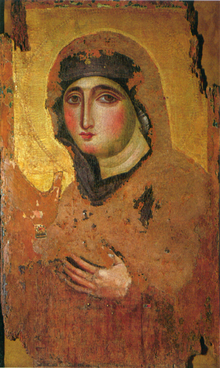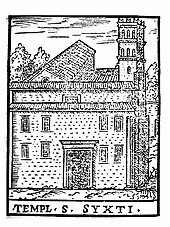
The Basilica of Saint Clement is a Latin Catholic minor basilica dedicated to Pope Clement I located in Rome, Italy. Archaeologically speaking, the structure is a three-tiered complex of buildings: (1) the present basilica built just before the year 1100 during the height of the Middle Ages; (2) beneath the present basilica is a 4th-century basilica that had been converted out of the home of a Roman nobleman, part of which had in the 1st century briefly served as an early church, and the basement of which had in the 2nd century briefly served as a mithraeum; (3) the home of the Roman nobleman had been built on the foundations of republican era villa and warehouse that had been destroyed in the Great Fire of AD 64.

The Latin Patriarchate of Alexandria was a nominal patriarchate of the Latin church on the see of Alexandria in Egypt.

The Minor Basilica of St. Lawrence in Lucina is a Roman Catholic parish, titular church, and minor basilica in central Rome, Italy. The basilica is located in Piazza di San Lorenzo in Lucina in the Rione Colonna, about two blocks behind the Palazzo Montecitorio, proximate to the Via del Corso.

Santa Cecilia in Trastevere is a 5th-century church in Rome, Italy, in the Trastevere rione, devoted to the Roman martyr Saint Cecilia.

San Marcello al Corso, a church in Rome, Italy, is a cardinalitial titular church whose cardinal-protector is normally of the order of cardinal priests.

The early Christian imperial basilica of the Saints Martyrs Vitale, Valeria, Gervasio and Protasio known more commonly as the basilica of San Vitale and Compagni Martiri in Fovea or more simply as San Vitale al Quirinale. It is the oldest Catholic place of worship in the historic center of Rome, located in via Nazionale. The imperial basilica of San Vitale al Quirinale, built under the pontificate of Pope Siricius after 386 and consecrated and richly decorated by Pope Innocent in 402 is the first public Christian basilica with a baptistery not founded on pre-existing pagan temples, mentioned in the Liber pontificalis, built by the Emperor Theodosius at the behest of Saint Ambrose of Milan, in honor of the miraculous discovery of the bodies of martyrs Gervasius and Protasius in Milan. It is the most frescoed basilica in Rome.
Saint Sixtus may refer to the following:

The Archdiocese of Santiago de Compostela is a Latin Church archdiocese of the Catholic Church in Spain. It is the senior of the five districts in which the church divides Galicia in North-western Spain.
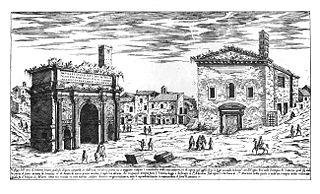
Sant'Adriano al Foro was a church in Rome, formerly in the Curia Julia in the Forum Romanum and a cardinal-deaconry.

The Diocese of Vieste was a Roman Catholic diocese located in the town in the province of Foggia, in the Apulia region of southeast Italy. On 27 June 1818, the diocese of Viesti was granted to the archbishops of Siponto (Manfredonia) as perpetual Administrators. On 30 September 1986, the diocese of Viesti was suppressed, its territory incorporated into the archdiocese of Siponto, and renamed the Archdiocese of Manfredonia–Vieste. Its former cathedral, named in honor of the Assumption of the body of the Virgin Mary into heaven, is now the Vieste Co-cathedral and, like nearly all cathedrals in Italy, a minor basilica.

The Diocese of San Marino-Montefeltro is a Latin Church ecclesiastical jurisdiction or diocese of the Catholic Church in both Italy and San Marino. It is a suffragan in the ecclesiastical province of the metropolitan Archdiocese of Ravenna-Cervia. The current diocese includes all the parishes of San Marino.

The Diocese of Osma-Soria is a Latin Church ecclesiastical territory or diocese of the Catholic Church in northern Spain. It is a suffragan diocese in the ecclesiastical province of the metropolitan Archdiocese of Burgos. Its cathedral episcopal see is Catedral de Santa María de la Asunción, dedicated to the Assumption of Mary, in El Burgo de Osma. It also has a co-cathedral, Concatedral de San Pedro, dedicated to St. Peter, in Soria, and a minor basilica: Basílica de Nuestra Señora de los Miagros Miagros, in Ágreda, Soria, Castile and León, Spain.
Pseudocardinals, quasi-cardinals or anticardinals were the uncanonical Cardinals created by six of the Antipopes, in or rival to Rome, including two of Avignon Papacy and one of Pisa, as princes of their schismatic government of the Catholic Church.
San Ciriaco alle Terme Diocleziane was a church in the Baths of Diocletian in Rome. It was made a titulus by the Roman synod of 1 March 499.

Pedro Ferris (1416–1478) was a Spanish Roman Catholic bishop and cardinal.
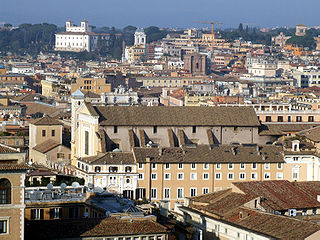
Santi Dodici Apostoli, commonly known simply as Santi Apostoli, is a 6th-century Roman Catholic parish and titular church and minor basilica in Rome, Italy, dedicated originally to St. James and St. Philip, whose remains are kept here, and later to all Apostles. Today, the basilica is under the care of the Conventual Franciscans, whose headquarters in Rome is in the adjacent building. It is the Station church for Friday, the first week of Lent.

The Diocese of Famagusta was a Latin Church ecclesiastical jurisdiction or diocese of the Catholic Church. Its episcopal see was the city of Famagusta, on the island of Cyprus during crusader rule, and is now a Latin Catholic titular see.
The Diocese of Novigrad was a Latin Church ecclesiastical jurisdiction or diocese of the Catholic Church located in the city of Novigrad, Istria, Croatia until it was suppressed to the Diocese of Trieste in 1831.
The Diocese of Cephalonia and Zakynthos was Roman Catholic diocese located on the Ionian Island of Cephalonia. It was suppressed in 1919.
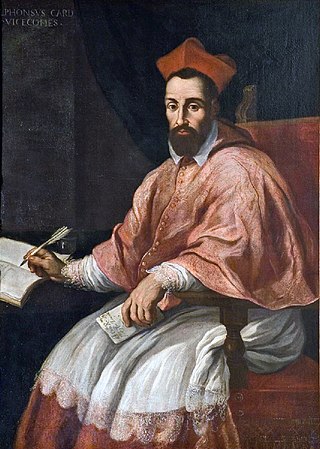
Alfonso Visconti (1552–1608) was an Italian Roman Catholic cardinal and diplomat.


